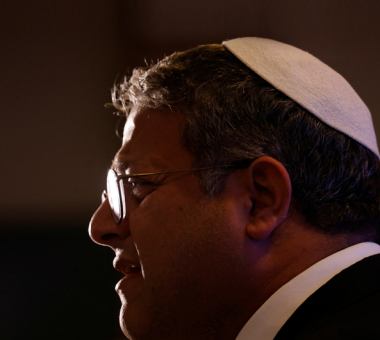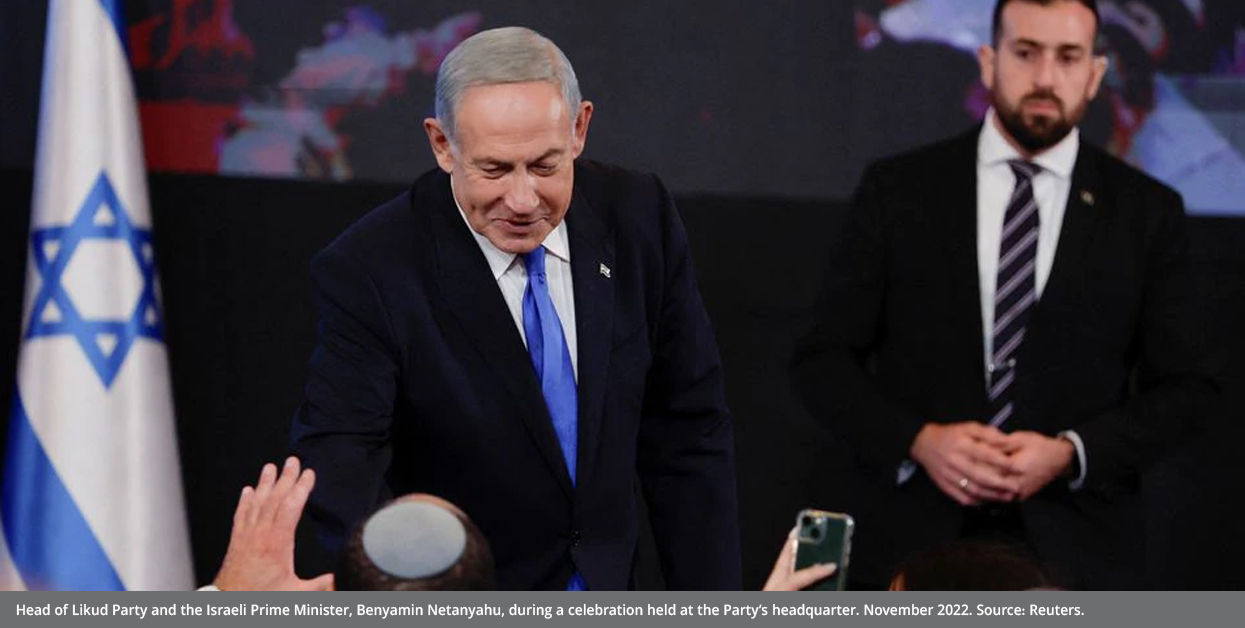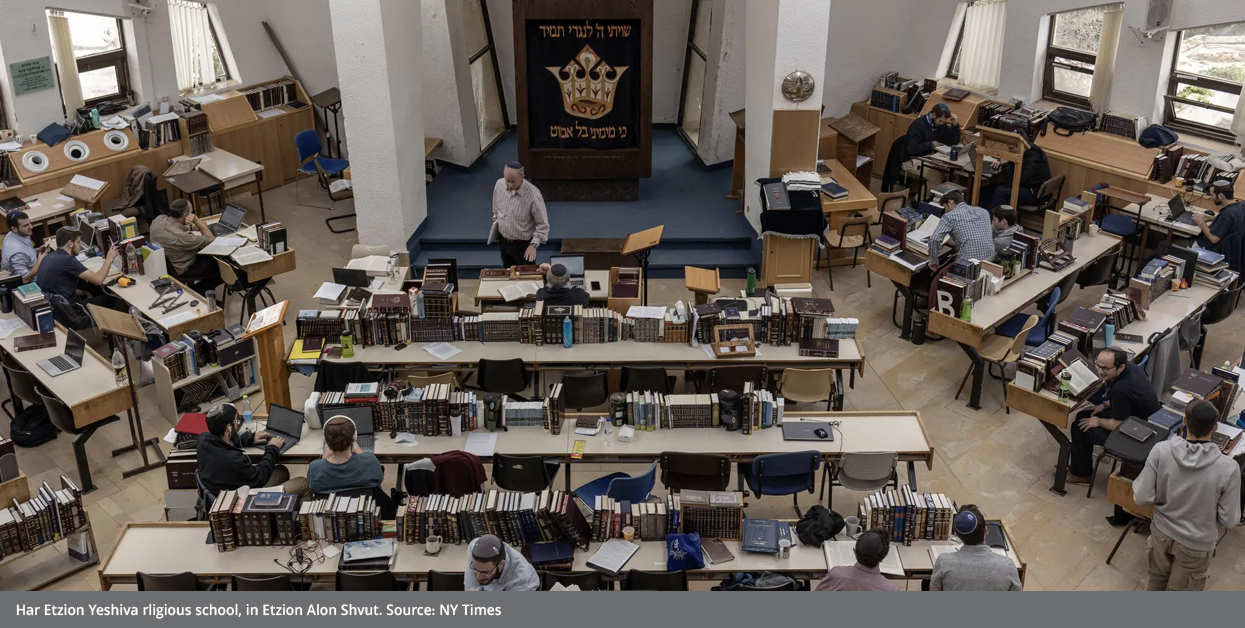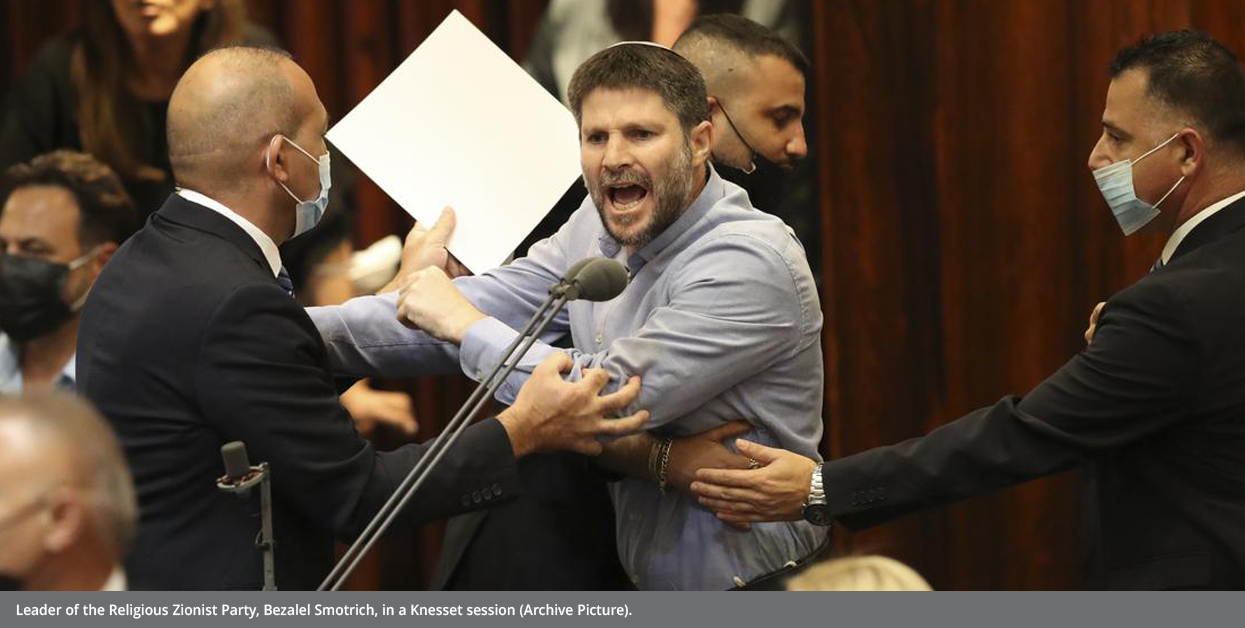Religious Zionism: Where is the Israeli Political Landscape Heading?
Position assessment | This paper addresses the rise of “religious Zionism” in Israel after the recent Knesset elections, a rise that will impose changes on the Israeli domestic landscape with repercussions on the Palestinian cause as well as regional and international levels.
by STRATEGIECS Team
- Release Date – Nov 25, 2022

Introduction
The triumph of the Religious Zionism Party coalition during the 25th Israeli Knesset elections has prompted numerous inquiries. These include questions about the origins and discourse of this particular brand of Zionism and how it sets itself apart from other forms of Zionism. Additionally, there are concerns about its potential role within the upcoming Israeli government, as well as the security and political implications of its victory for Israel, its Palestinian and Arab neighbors, and the wider regional and international community.
The Religious Zionism alliance, which consisted mainly of Israel Finance Minister Bezalel Smotrich’s far-right Jewish Unity Party and the far-right Otzma Yehudit Party, won 14 seats in the November 2022 Knesset elections after more than half a million Israeli voters voted for it, becoming the third parliamentary bloc after Israeli Prime Minister Benjamin Netanyahu’s Likud Party (32 seats) and former Israeli Finance Minister Yair Lapid’s Yesh Atid Party (24 seats).
Despite the ostensibly huge leap between the number of seats of the Religious Zionist Alliance in the 24th Knesset elections (where it only won six seats) and the recent elections (winning 14 seats), the real leap occurred in the concentration of religious Zionism supporters’ into one list, which was Religious Zionism. Such supporters were divided between that list and the list of the Yamina Party headed by former Israeli Prime Minister Naftali Bennett, which won seven seats in the 24th Knesset elections. The two lists combined forces after the Yamina Party dissolution and Bennett’s decision to withdraw from political life.
However, this does not diminish the importance of this leap, as the progress of religious Zionism movement in general was characterized by ups and downs over the past two decades, culminating -in the recent elections with the concentration of seats for one coalition representing Religious Zionism in the Knesset, making it a central partner in the next right-wing government headed by Netanyahu.

Religious Zionism: Emergence and Progress
The term “religious Zionism as defined in the Jewish Encyclopedia refers to the religious Zionist movement, not to be mistaken for the mainstream secular Zionist current that in 1902 was transformed into a political movement called Hamizrahi, an abbreviation of the Hebrew words “Merkaz Rouhani,” meaning spiritual center. Taking the slogan “The Land of Israel for the People of Israel According to the Law of Israel,” supporters of religious Zionism argue that Israel is a nation distinct from other nations because the Jewish nation belongs to God and that the union of the true Jewish entity (Israel) is maintained only by directing Jewish thought towards the Torah and Palestine as the important twin pillars in the history and life of the Jewish nation.
The HaMizrachi movement, in turn, merged in 1956 with the Hapoel HaMizrahi movement to form the National Religious Party (Mafdal), which witnessed ups and downs due to internal divisions and the emergence of other religious Zionist parties, the most important of which are the Kach Party founded by the extremist Rabbi Meir Kahane, the Tami Party, the Matsad movement, the Meimad Party, and the Gush Emunim settler movement, among others.

Thus, we can see that religious Zionism’s progress has had ups and downs, depending on the circumstances either surrounding Israel or within it. Such progress was not necessarily a constantly rising one. In its most intensive moments of decline, the religious Zionism movement witnessed many rifts and changes, facing a decline in its popularity several times. Nevertheless, it remains a central phenomenon within the currents of the Zionist movement and in Israeli society. even
This is evident by reviewing some important milestones in the progress of the religious Zionism movement after the formation of the National Religious Party.
- The Mafdal Party won 12 seats in the Fourth Knesset, but its popularity witnessed a decline, and it won only three seats in the 18th Knesset.
- The Mafdal Party and the Jewish Home Party, initially led by Bennett, merged. They both won 12 seats in the 19th Knesset, participated in the government, and then won eight seats in the 20th Knesset before facing a sharp split in their ranks, pushing to run in the elections for the 21st Knesset with two different lists: The New Right list, led by Bennett and former Interior Minister Ayelet Shaked, which did not win any seats, and the Union of Right-Wing Parties (The Jewish Home, National Union, Jewish Power) led by former Chief Military Rabbi of the Israeli Defense Forces Rafi Peretz, Smotrich, and National Security Minister Itamar Ben-Gvir, a list that won five seats.
- The party returned united again under the name of Yamina led by former Interior Minister Ayelet Shaked after the exit of Ben-Gvir’s followers due to the secularism of Shaked. Yamina won seven seats in the 22nd Knesset, six seats in the 23rd elections, and seven seats in the 24th Knesset led by Bennett. Meanwhile, the Religious Zionism alliance led by Smotrich and Ben-Gvir, got six seats.
- The Yamina Party was dissolved, and the Shaked’s Jewish Home Party did not pass the threshold in the 25th Knesset elections. Smotrich and Ben-Gvir’s Religious Zionist alliance rose and won six seats in the 24th Knesset before getting 14 seats in the last election.
The reasons for the recent rise of religious Zionism in the elections for the 25th Knesset are multiple.
- The emergence of significant role of the Palestinian Arab community and its political forces inside Israel, especially after the events which took place in Sheikh Jarrah, and the escalation of the far-right discourse that warns against the danger of Palestinians inside Israel to the so-called “Jewishness of the state” and its future.
- The ongoing escalation in the West Bank, including East Jerusalem.
- The growing power of the settlers and their role in the Israeli security and military establishment.
- The inability of Bennett’s government—Bennett was the first Religious Zionist Party member to reach the post of prime minister—to convince the far-right public of its ability to represent them, especially after Bennett’s alliance with the United Arab List and the left-wing Meretz Party.
From the Zionising Judaism to Judaizing Zionism
Religious Zionism currents, regardless of how many, have ideological, political, and social basis in common that distinguish them from secular Zionist movements and orthodox non-Zionist Jewish currents. In its founding discourse, religious Zionism merged the statements of Orthodox religious Judaism (stemming from the Torah, like the people of Israel, the law of Israel, and the Jewish nation) with the secular political Zionist movement that champions the national homeland and the establishment of the State of Israel in Palestine. Religious Zionism is distinguished from secular Zionism by seeking to Zionize and nationalize Judaism. It is also distinguished from Orthodox Judaism, which denies Judaism Zionism and rejects the political exploitation of the Torah.
Thus, Religious Zionism has taken a different path, which is closer to the Judaization of Zionism, combining the Torah and Palestine as the basis for the political legitimacy of the State of Israel as the state of the Jewish nation, which is itself the people of Israel.

The most important premises of religious-ideological Zionism, its political and social positions, find their expression in the speeches of Smotrich and Ben-Gvir, its most prominent representatives. There are five key premises.
First, the centrality of “The Land of Israel for the People of Israel According to the Law of Israel” slogan. This slogan has been central starting from the moment religious Zionism was established until now. Such a slogan is central all religious Zionism currents as well.
Second, seeking to annex the entire West Bank, reoccupy the Gaza Strip, and absolutely rejecting the establishment of a Palestinian state. On the way to achieving these goals, Religious Zionism called to granting full legitimacy to all settlement outposts, intensifying settlement activity, and lifting all restrictions on it. It also called for confronting the Palestinian control over non-residential lands, dismantling the Israeli Civil Administration in the West Bank, transferring its powers to Israeli ministries, and, as a prelude to full official annexation, effectively implementing gradual annexation of the West Bank lands, tightening Israeli control over Jerusalem, and demanding the opening of al-Aqsa Mosque permanently for Jewish worshippers.
Third, considering Palestinians inside Israel a strategic threat to the “Jewishness” of the state;, dealing with this perceived threat through violent measures such as banning Arab parties, positioning Israeli military units inside Palestinian cities and towns in Israel to confront future demonstrations similar to the events of May 2021; suppressing the leaders of Palestinians inside the country; deporting those leaders deemed to be so-called “supporters of terrorism,” including some Knesset members; expelling Arabs who are accused of not being loyal to the state; imposing the death penalty on those described as saboteurs; changing the orders to allow live ammunition against protesters; lifting restrictions on Israeli soldiers and police activities against Palestinians inside Israel and in the West Bank; increasing settlement and Jewish presence in the Galilee and the Negev, and so forth.
Fourth, seeking to implement the saying “The Torah is the constitution of Israel and it is the DNA of the Jewish State” by applying Jewish religious law in areas of public life in Israel, including suspending official events and activities on the Sabbath, repealing liberal laws regarding women and homosexuals, banning intermarriage between Jews and non-Jews, and limiting secularists, etc.
Fifth, tightening some partisan positions that are consistent with the positions of the Likud Party and in support of Netanyahu, such as demanding reforms in the judiciary that will subject it to the legislative authority of the Knesset; replacing judges; and working to prevent Netanyahu’s prosecution by seeking to abrogate the “breach of trust and fraud clause of the anti-corruption law, among others.
Future Repercussions
In general, the repercussions of the Religious Zionism Party’s great victory alliance in the recent Knesset elections are not isolated from the victory of the right-wing camp and the extreme right in all its currents—rather, it is an integral part of it. Such victory reflects an increasing quantity of right-wing extremism, not an increase in its quality, especially after the exit of the left-wing Meretz Party for not achieving decisive percentages and the centrist Labour Party winning only four seats. Given that the right wing will lead the next Israeli government, the most important repercussions will affect four levels of governance and politics.
The Israeli Level
The Israeli political arena may witness a strengthening of the far-right currents’ power, especially the religious ones. It may also witness an increase in their influence and support for their social and educational institutions, as well as the tightening of measures against Palestinian citizens of Israel, and an increase in the confiscation of their land in the Galilee and the Negev, especially in the case of Ben-Gvir’s assumption of the Ministry of National Security, in addition to the adoption of new laws more in line with Jewish law, especially with regard to women and homosexuals, which will deepen the social rift in Israel between secular and religious people.
The Palestinian Level
It is possible that the political stalemate in the relationship between the Israeli government and the Palestinian Authority will continue. The negotiations with Hamas on the prisoner exchange file may falter due to the positions of the hard-line religious Zionist alliance on this issue. An increase in the pace of settlements may occur, especially in Jerusalem, Hebron, and Nablus. Religious Zionism may seek to impose a new reality in the Al-Aqsa Mosque through the “space-time” division that allows Jewish extremists to enter it permanently, which may support the outbreak of violent confrontations throughout the Palestinian territories.
On November 16, 2022, Israeli Channel 13 announced Netanyahu’s agreement with Ben-Gvir to amend the Disengagement Plan Implementation Law (known as the Gaza Separation Law) introduced by former Israeli Prime Minister Ariel Sharon which mandated Israeli withdrawal from the Gaza Strip and four settlements in the northern West Bank by September 2005. This amendment may pave the way for settlers to return to the four settlements, undermines Sharon’s plan, and reinforces the rhetoric of religious Zionism and the extreme right that the West Bank and Gaza as part of the “Land of Israel.”
The Jordanian Level
Jordan-Israel relations may witness limited tension regarding the issue of Jerusalem, holy sites, and the Al-Aqsa Mosque, especially in the event that the Israeli government makes changes to the status quo in Al-Aqsa Mosque in terms of “space-time” division or abusing the mosque’s Ministry of Endowment employees and guards. Extremist Jewish groups may storm the mosque and hold biblical rituals in it. But at the level of official political and economic relations, the situation will remain the same, and may even improve due to Netanyahu’s keenness to strengthen Israel’s Arab, regional, and international relations.
The International Level
As for the United States, there is great harmony between the discourse of the Republican Party and the conservative Christian right in America and the nationalist right parties, especially the Likud Party, in Israel. This is not the case, relatively speaking, with the ruling Democratic Party. Thus, for now, the victory of the religious Zionism current is not welcomed in the United States, although it is not expected that its presence in the next Israeli government will have a negative impact on the positions of the United States towards Israel by virtue of the strategic relations nature between them and the centrality of the Likud Party and Netanyahu in the management of Israeli foreign policy.
Conclusion
The results of the 5th Knesset elections represent the culmination of the rise of the Israeli right in general, the extreme right in particular, and the more extreme religious Zionism specifically. The culmination point, indicated in the upcoming government coalition, is intensified between the far-right Likud party (32 seats) and the ultra-Orthodox Shas Party representing the Sephardim and Mizrahi Haredi Jews Party (11 seats), the United Torah Judaism Party representing religious Jews of western descent (7 seats), and the most extreme Religious Zionist Party (14 seats), a culmination that underscores the depth of the right-wing shift in Israeli politics and the high degree of legitimacy achieved by religious Zionism decades after one of its most important components, the Kach-Meir Kahane movement, was classified within Israel as a racist terrorist movement, of which Ben-Gvir is the heir and most prominent representative.
However, this transformation will have moderate social, security, and political effects within Israeli society itself, Israel’s relations with Palestinian citizens inside the Green Line, and in its relations with the Palestinian Authority and Palestinian citizens in the West Bank, including East Jerusalem and the Gaza Strip.

STRATEGIECS Team
Policy Analysis Team
 العربية
العربية